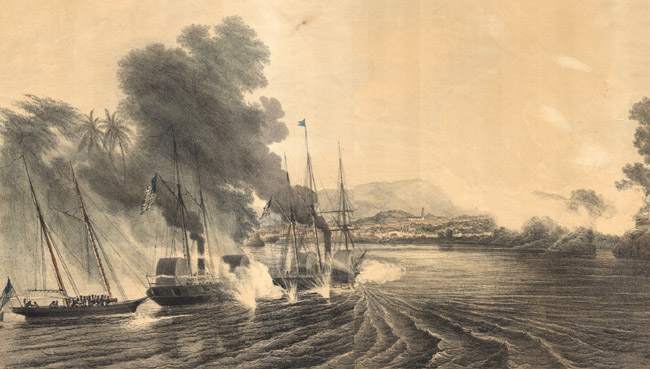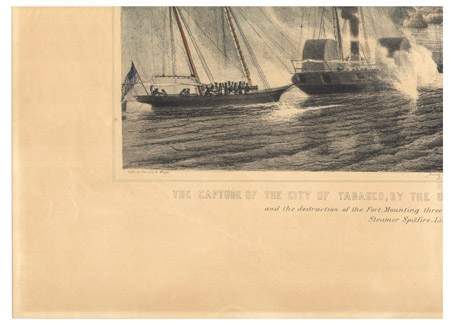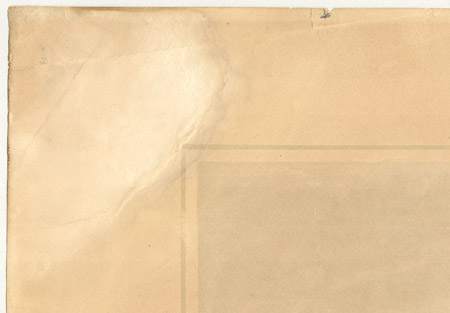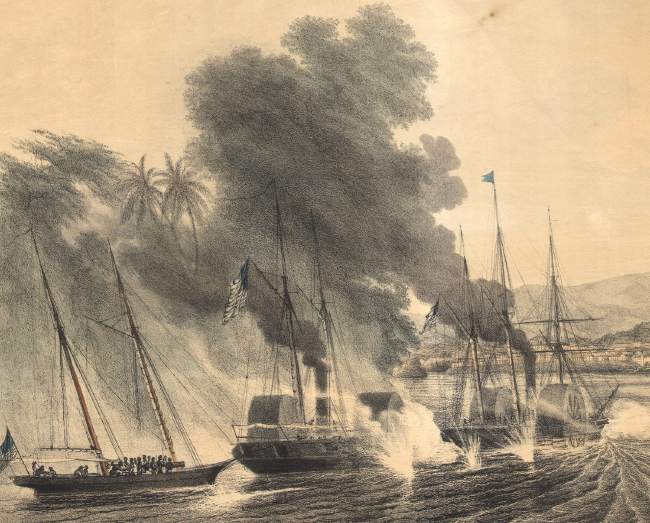|
~~ 1848090524-7 ~~
Naval Portfolio, No 7.
Henry Walke

Condition. The lithograph is in Good condition. The following comments are offered.
Overall Condition of Paper. The paper is toned. The back is much more toned than the front. The paper is supple and not brittle.
Lithograph Paper Compared Against a Bright White Background

Foxing, Staining & Discoloration. The upper left corner of the lithograph is discolored, rubbed, stained and creased. This extends into the image box but not into the image area of the plate.
 There is a 1x1 cm stained area in the sky above the first steamer. Above that and to the right is a much less noticeable lightly stained area about the same size. There is discoloration in the margins. At about the 1/3 point, below "Portfolio" at the top there is a vertical band (ca 2 cm wide) where the paper is lighter in color. This is not noticeable when it gets to the steamer. The entire band is visible when the plate is viewed from the back.
There is a 1x1 cm stained area in the sky above the first steamer. Above that and to the right is a much less noticeable lightly stained area about the same size. There is discoloration in the margins. At about the 1/3 point, below "Portfolio" at the top there is a vertical band (ca 2 cm wide) where the paper is lighter in color. This is not noticeable when it gets to the steamer. The entire band is visible when the plate is viewed from the back.
Tears & Creases. The lithograph does not have significant tears or creases in the image area. The condition of the upper left corner is discussed above. There is moderate creasing in the bottom left corner. The tip of the bottom right corner has a 1.5 cm piece missing. The upper right corner is creased and appears to have been repaired. There a several (4-5) small tears in the margin but none exceeds 1.5 cm in length.
Back of the Lithograph. To see a view of the entire back of the lithograph, click here.
Size of the Lithograph Plate. I believe the plate is untrimmed. It has full and relatively even margins. The plate measures 20 3/4 x 26 3/4+ in (53 x 68 cm).
Henry Walke's Classic Naval Lithograph Portfolio.
Perhaps the rarest American Naval print series was created by then Lieutenant H. (Henry) Walke. It is a series of eight lithographs depicting Naval actions in the Mexican War in the Spring and Summer of 1847. Walke served in the war as the second in command of the U.S.S. Vesuvius, a bomb brig of the Gulf Squadron. During the war the Vesuvius participated in the blockade of Laguna and supported landings at Tuxpan and Tabasco.
After serving for eight months on the Vesuvius, Walke returned to the United States in October 1847 and went on extended leave until September of 1848. On his return he immediately began work on his Naval lithograph portfolio and it was completed during this period.
All of the lithographs were after original art by Walke. He personally rendered five of them onto the lithograph stones. Numbers 1, 3, 4, 5 & 7 were executed by Walke onto the lithograph stones. The others (Nos. 2, 6 & 8) were executed on the lithograph stones by others but based upon Walke's original art.
"Naval Portfolio .... No. 1~8" is stated at the top of each lithograph. There is also a line of text in smaller print reading "Naval Scenes in the Mexican War by H. Walke, Lieut. U.S. Navy." The image is surrounded by a thick (2~4 mm wide) frame box. Directly below the image and within the frame box, small print text is seen at the left (lithographer - "Sarony & Major"), middle ("Entered according to Act of Congress in the year 1847 (1848)...."). Those lithographs actually executed by Walke on the lithograph stone (Nos 1, 3, 4, 5 & 7) state "Executed by H. Walke, Lt, U.S.N." or "Designed and Drawn on Stone by H. Walke, Lt, U.S.N." at the far right. When the H. Walke work was actually rendered onto the lithograph stone by another artist (Nos. 2, 6 & 8) at the far left it states "Painted by H.Walke L. U.S.N, Drawn on Stone by (name of artist)." At the bottom under the image frame box in large print is the title of the image in double line letters. This is followed by lines of smaller print with descriptive text which contains a date of for the naval action depicted. On some of the lithographs the name and address of the lithographer/publisher ("Published by Sarony & Major, 117 Fulton Street, New York.") is stated below the descriptive text. The name of the publisher/lithographer (Sarony & Major) is often found at the far right or far left under the image but within the image box.
The plate size of these lithographs is generally 20 3/4 x 26 3/4+ in (53 x 68 cm). The Yale University Library lists the size of the prints as 54 x 73 cm. The image areas (including the image frame box) vary slightly but generally measure 15~15 1/4 x 21 1/4~22 1/2 in (37.8~38.5 x 53.8~56.8 cm).
The most of the lithographs I would call tinted lithographs. There are executed in black & white and contain an additional tint color tint. Some of the lithographs contain more that one tint and appear to be properly classified as multi-color (chromolithographs).
This work is sometimes described as a book. It apparently was issued with a folio case to house the loose lithographs. Complete sets of all eight lithographs are rarely seen. Even single lithographs are seldom seen and generally in poor condition. The Library of Congress on-line exhibit titled "Pictorial America" contains all 8 of these lithographs.
Naval Portfolio No. 7
Title: No. 7. "The Capture of the City of Tabasco, By the U.S. Naval Expedition, Afloat and on Shore, Under Comore. M.C. Perry."
"and the destruction of Fort, Mounting three long 26 pounders,' with other heavy guns, by the U.S. Steamers Scorpion, Comer. Bigelow. Steamer Spitfire, Lieut Coming. S.S. Lee, and Schooner Bonita, Liut. Coming. Berrian. June 15th. 1847. Published by Sarony & Major 117 Fulton St. N. York."
"Designed and Drawn on Stone by H. Walke, Lieut. of U.S.N. New York"
The image presented in this lithograph was discussed by William Elliot Griffis in his biography of M. C. Perry.
THE NAVAL BRIGADE. CAPTURE OF TABASCO.
It was now past six o'clock (June 14, 1847) and it was determined to anchor for the night. The whole squadron assembled in the Devil's Turn, and anchored in sight of the Seven Palm Trees below which the obstructions had been sunk. Due precautions were taken against a night attack, as the dense chapparal was only twenty yards distant. A barricade of hammocks was therefore thrown up on the bulwarks for protection, and the sailors, as soldiers are, in rhetoric, said to do, " slept on their arms." But one volley was received from the shore during the night, the air only receiving injury.
The enemy had placed obstructions at the bar to prevent the further ascent of our forces. The Commodore, early in the morning (June 15, 1847), dispatched two boats with survey officers to reconnoiter and sound a channel. These drew the fire of a breastwork, La Comena, on the shore, which severely wounded Lieutenant William May.
The boats having been unable to find a channel, Perry gave orders to land. With grape, bombs, and musketry, the fleet cleared the ground, and then Perry gave the order, "Prepare to land," and led the way in his barge with his broad pennant flying. All eyes watched his movements as he pulled up the river. When opposite the Palms, he steered for the shore, and with his loud, clear voice heard fore and aft, called out, " Three cheers, and land ! " The cheers were given with enthusiasm, and then every oar bent. His boat was the first to strike the beach, and the Commodore was the first man to land. With Captain Mayo and his aids, he dashed up the nearly perpendicular bank, and unfurled his broad pennant in the sight of the whole line of boats. Instantly three deafening cheers again rang out from the throats of a thousand men who panted to be near it and share its fortunes. It was a sight so unusual, for a naval Commander-in-chief, to take the field under such circumstances at the head of his command, that the enthusiasm of our tars was unbounded and irrepressible. They bent to their oars with a will and pulled for the shore.
The artillery and infantry were quickly landed on the narrow flats at the base of the high banks. Reaching these, the infantry were formed in line within ten minutes. Then came the tug-work of drawing seven field pieces up a bank four rods high, and slanting only twenty-five feet from a perpendicular. With plenty of rope and muscle the work was accomplished. Three more pieces were landed later from the bomb ketches and added as a reserve. Most of the landing was done in five, and all within ten, minutes. In half an hour after the Commodore first set foot on land, the column was in motion as follows: — The pioneers far in advance under Lieutenant Maynard, the marines under Captain Edson, the artillery under Captain Alexander Slidell Mackenzie, and the detachments of seamen under the various captains to whose ships they severally belonged. Captain Mayo acted as adjutant general, the Commodore giving his personal attention to every movement of the whole. In this, as in all things, Perry was a master of details.
The march upon Tabasco now began, the burly Commodore being at the front. Through a skirt of jungle, then for a mile through a clear plain, and again in the woods, they soon came in sight of Acachapan where an advancing company of a hundred musket-men opened fire on our column. At this chosen place, the Mexican general had intended to give battle, having here the main body of his army with two field pieces and a body of cavalry. At the first fire of the Mexican musketry, our field pieces were got into position, and a few round shots, well served, put the lessening numbers of the enemy to flight. The terrible execution so quickly done showed the Mexicans that the Americans had landed not as a mob of sailors but a body of drilled infantry with artillery. A change came over the spirit of the orator, Bruno, and he fell back in his entrenchments. The road wound near the water and the march was recommenced.
Meanwhile the ships left in the river were not idle. The flotilla, led by the Spitfire under Lieutenant, now Admiral Porter, had passed the obstructions, and according to Perry's orders, were gallantly ascending near the fort and town. The three hearty cheers which were exchanged between ships and shore when the two parties caught sight of each other, greatly intimidated the veteranos in the fort. Behind the deserted breastworks of Acachapan, our men found the usual signs of sudden and speedy exit. Clothes, bedding and cooking utensils were visible. The bill of fare for the breakfast all ready, but untasted, consisted of boiled beef, tortillas, squash and corn in several styles.
Without delaying here, the advance column passed on and rested under several enormous scyba trees near a lagoon of water. Officers and men had earned rest, for the work of hauling field pieces in tropical weather along narrow, swampy and tortuous roads, and over rude corduroy bridges hastily constructed by the pioneers, was toilsome in the extreme. In some cases the wheels of a gun carriage would sink to their hubs requiring a whole company to drag them out. Some of the best officers and most athletic seamen fainted from heat and excessive fatigue, but reviving with rest and refreshment, resumed their labors with zeal that inspired the whole line. This march overland of a naval force with artillery along an almost roadless country seemed to demoralize both the veterans and militia in fort and trenches.
The Spitfire and Scorpion passed up the river unmolested until within range of Fort Iturbide, a shot from which cut the paddle wheel of the Spitfire. Without being disabled, the steamer moved on and got in the rear of the fortification, pouring in so rapid and accurate a fire, that the garrison soon lost all spirit and showed signs of flinching. Seeing this, Lieutenant, now Admiral, Porter landed with sixty-eight men and under an irregular fire charged and captured it, the Mexicans flying in all directions. The town was then taken possession of by a force detailed from the two steamers, under Captain S. S. Lee, Lieutenant Porter remaining in command of the Spitfire. (At page 243-247, Matthew Calbraith Perry, A Typical American Naval Officer, William Elliot Griffis, Boston & New York, Houghton, Mifflin & Company, 1890)
A tinted lithograph. The plate measures 20 3/4 x 26 3/4+ in (53 x 68 cm). The image (including the image frame box) measures 15 1/8 x 21 3/4 in (38.4 x 55.5 cm).
Close-up of the Title at Top

Close-up of the Ships

Close-up of the Lettering/Descriptive Caption

Close-up of the Lithographer

Close-up of "Entered According to Act of Congress"

Close-up of Artist's Name

This is one of the five lithographs which Walke personally drew on the lithographic stones.
To return to the main page on Henry Walke, click here.
|








